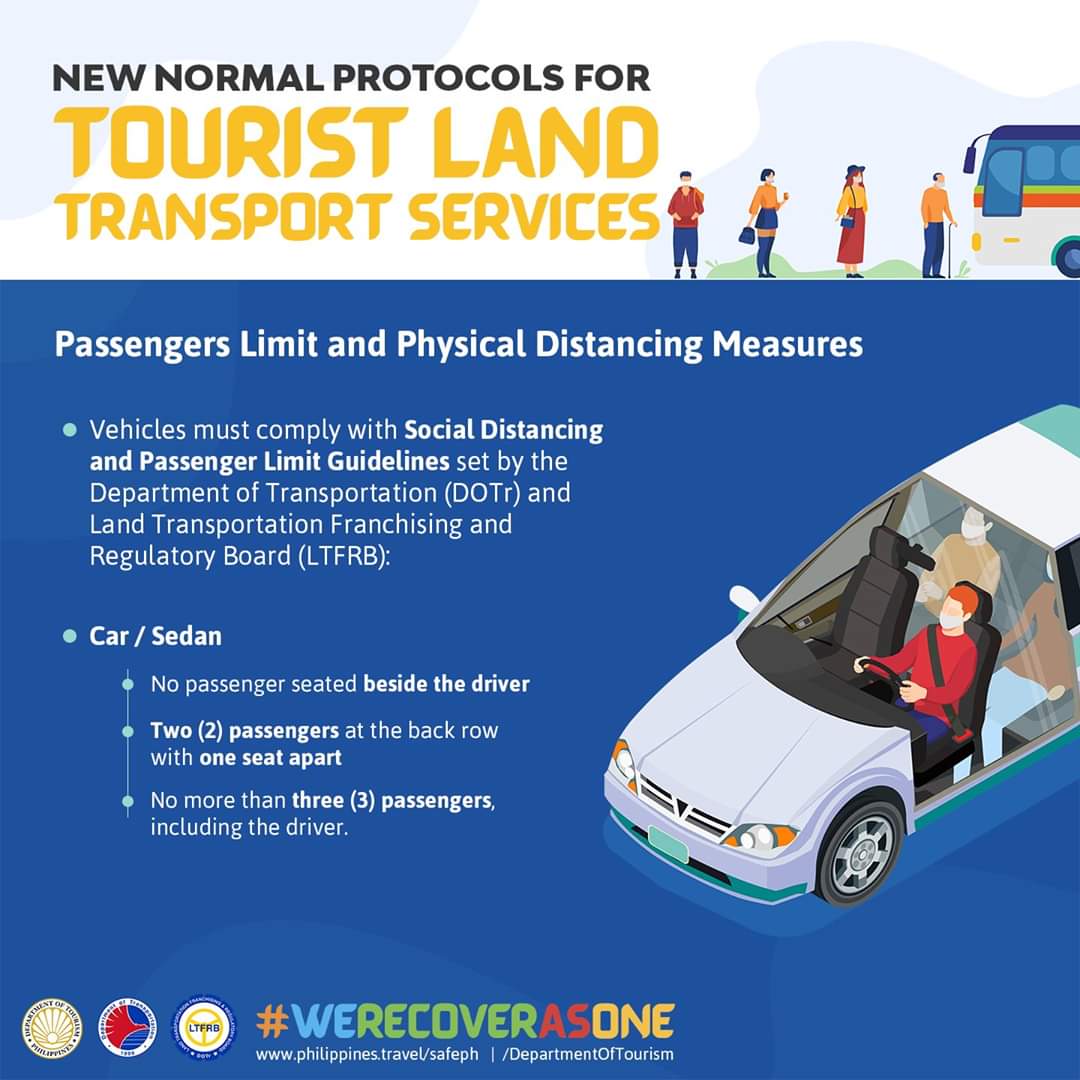By Rey Anthony Chiu, PIA-Bohol | 11:07 PM June 13, 2020

It would now be illegal for a tourist car transport to sit four, as the new normal for tourist land transport services guidelines show.
Or at least until the corona virus disease (COVID-19) pandemic has been totally eradicated by widespread immunization, the Department of Tourism (DOT), as directed by the President under Republic Act (RA) No. 11469 or the Bayanihan To Heal as One Act, has been authorized to direct the operation of establishments to carry out the declared national policy of mitigating the transmission of COVID-19 and implements such as Bohol contemplates on opening the tourism sector under the new normal.
According to the DOT, the New Normal Health and Safety Guidelines for Tourist Land Transport Services include a policy monitoring body temperatures which would force transport operators to provide a portable thermal scanner in a thermometer gun and Basic First-Aid and Sanitation Kits, disposable cloths and cleaning agents and hand gloves for use by the driver when a need arises.
The transport operator must also prepare in the vehicle 70% solution alcohol or alcohol-based hand sanitizer and tissue paper or disposable wet wipes, free for use by passengers.
For the driver, other than the portable thermal scanner, the operator shall provide a face-mask be they surgical of cloth, hand sanitizer, paper towels or tissue, disinfectants, personal protective equipment (PPE), and the Passenger’s Information sheet which contains the names, addresses, and contact details of the passengers for easier contact tracing, subject to the provisions of Republic Act No. 10173 or the Data Privacy Act.
Vehicles must also comply with the Department of Transportation and Land Transportation Franchising Regulatory Board measures on Social Distancing and Passenger Limit Guidelines.
For cars and sedans, no passenger should be seated beside the driver and only two passengers are allowed at the back row, seating one seat apart. This means a car will have no more than 3 passengers, including the driver.
For tourist vans, the guidelines allow only 2 passengers per row, except for the driver’s row where a passenger may occupy the passenger’s seat.
Operators must also make sure that a waterproof transparent barrier between the driver and the passengers are installed.
For buses and coasters, they shall only carry 50 percent of their total registered carrying capacity, waterproof transparent barrier between the driver and the passengers and passengers seated one seat apart, standing passengers not allowed.
The above measures may be revised subject to updated issuances by the DOTr and/or LTFRB.
To ensure that the passenger limit and physical measures are complied with, vehicles will have markings that will guide passengers as to which seats are available for use, non-permeable or acetate seat barriers may also be installed to limit contact between passengers.
The guidelines also state that all vehicles should contain notices with appropriate information on the prevailing disease, as well as the policies enforced to reduce the risk and spread of the disease.
Information materials on hand disinfecting and respiratory etiquette, proper use of face mask, emergency contact numbers, among others, must be provided to passengers.
This is despite that fact that deep cleaning and proper disinfection and sanitation of vehicles must be done before and after every use. Disinfection emphasis would be on frequently touched surfaces such as seats, arm rests, door handles, light and air controls, and the like.
The vehicle should be well ventilated and air conditioning shall be on non-recirculated mode to maximize air changes that reduce potentially infectious particles in the vehicle, according to the guidelines.
On waste materials on board, these shall be kept in a clean and hygienic condition: a separate trash bag is set for all gloves, facemasks, PPEs, wet wipes, and other sanitation disposables used by the passengers, its disposal shall be in accordance with any special instructions relating to the materials, to be disposed of immediately upon arrival at the destination.
The vehicle must also have an emergency directory with emergency hotlines of clinics and hospitals located in the city and municipality within the route, police and fire stations located in the city/municipality within the route and other emergency responders whether public or private located in the city/municipality within the route.
On another hand, drivers must observe personal hygiene, good grooming: wear of clean clothes and uniform, closed shoes while on duty, wearing of appropriate personal protective equipment (face masks and gloves) properly at all times while on duty, avoiding physical contact with the passengers and observing physical distancing,
frequently wash hands with soap and running water of 70% solution alcohol or alcohol-based hand sanitizers.
They must also practice good respiratory etiquette by covering nose and mouth when coughing or sneezing, frequently cleaning and disinfecting the vehicle and opening the windows to air out the vehicle after every trip.
Drivers also need to accomplish an itinerary or trip ticket for every trip for proper documentation and reference.
For passengers, those not wearing masks would not be allowed to board the vehicle while upon the mandatory thermal scanning, a passenger is found to have fever or is exhibiting flu-like symptoms, the passenger shall be immediately transported to a healthcare facility or hospital for further evaluation.
The guidelines said any violation subjects the tourism enterprise to the appropriate fines and penalties, including revocation of its DOT Accreditation, in accordance with relevant laws, rules, and regulations.




